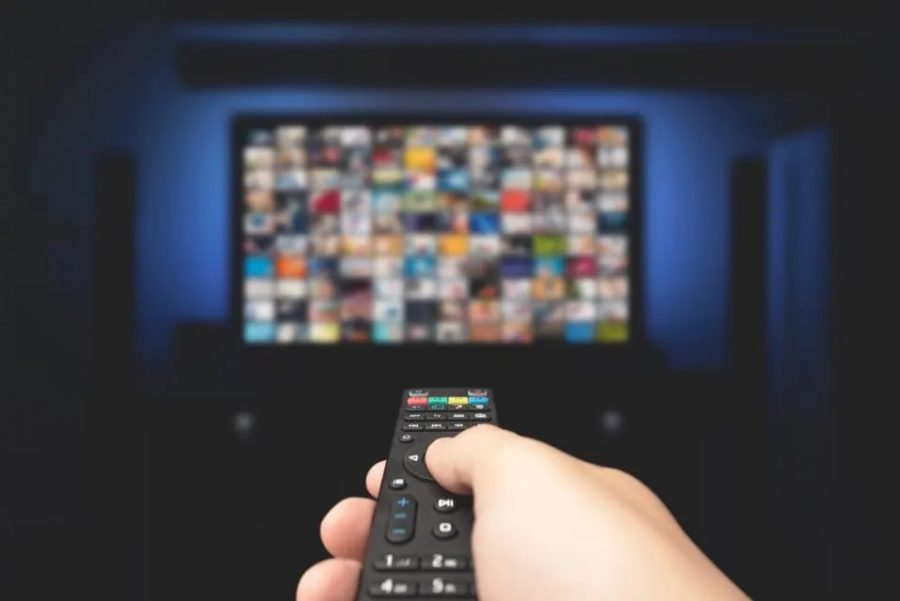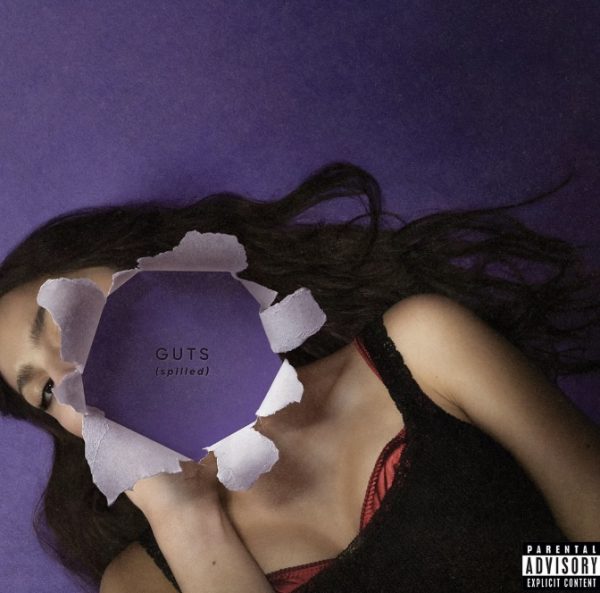Is binge-watching ruining entertainment?
May 30, 2023
The time is now.
You’re rushing downstairs with a grand smile from ear to ear, a euphoric feeling washing over you as the hour becomes evident in your peripheral vision. It’s Friday, six o’clock to be specific, and the sun is slowly waning and fading from the sky. You have nothing more to look forward to than your favorite show, having waited all of seven days in anticipation of the huge cliffhanger of the previous week.
There’s a hot, cheesy pizza awaiting you in the kitchen; its aroma pulls on your heartstrings as the opening sequence plays in the other room. Taking a seat on your couch and reclining to maximum comfort, you are glued to the screen for the next 20-50 minutes with your friends or family.
Nothing is better.
This is the case when episodes of your favorite show are released weekly. Binge-watching is a much different experience.
Binge-watching is the practice of watching multiple episodes of a television program in rapid succession. Over the course of the pandemic, batch releases, or releases of seasons at a time, have become massively popular, because that is how people in the pandemic would prefer to watch.
In turn, the thought of weekly releases has diminished, meaning that you will be waiting weeks or months at a time to get your fix. Within the cutthroat world of streaming, there is a consistent debate as to the right option between batch and weekly style releases.
Perpetual Pace of L’s
When it comes to streaming platforms, the most popular platform you think of is Netflix. Netflix has been an absolute powerhouse, dominating the industry for over a decade, yet through the first three quarters of this year, Netflix has been shedding subscribers, losing viewers, and collecting losses.
Since 2021, Netflix has dropped around 10% of its market share in the U.S., which is a whopping downgrade for the streaming juggernaut. Despite being the first streaming service that comes to mind to any viewer, Netflix is undoubtedly losing a bit of popularity.
Within this loss, there are admittedly many factors that contribute to the overall change of opinion, such as the steady increase in price, and the loss of big-name shows and movies within the service. But, most importantly, Netflix refuses to stray from its binge-focused model, despite recent controversy over this much-needed change.
Videos, blogs, and articles continuously appear with negative sentiment toward batch-style releases in which Netflix, the most popular streaming service there is, is the biggest culprit. They defend this decision in their 3rd quarterly shareholder letter, as its binge-able release model helps drive substantial engagement, especially for newer titles.
It’s a multifaceted failure.
Not only do batch releases incentivize the opposite of substantial engagement, but they also proved themselves to be wrong with Stranger Things, as the two-part season led to an absolute ubiquity of badass Hellfire Club t-shirts. Additionally, this season is the second most watched season across all of Netflix, boasting over a billion hours of watch time.
There is no sense in maintaining this model: popularity is proven better by splitting it up at the very least.
Change of Pace
Conversely, views have spread much further than just Netflix; With the rise of streaming services Amazon Prime and Disney Plus, each platform has maintained an increase in market share of up to 5%. This rise demonstrates popularity gain with the weekly model, as the oversaturation of batch releases in Netflix combined with the overwhelming number of viewers that arose during the pandemic led to an inevitable decline of its own accord.
That’s not to say that they aren’t being used for their enjoyable classics or unique exclusives, but clearly, there is a broader enjoyment when it comes to week-based releases.
Take Disney Plus for example: since the first quarter of 2019, they have grown by a grandiose 137 million subscribers compared to the 56 million that Netflix grew. Especially after their loss of subscribers in the first two quarters of this year, Netflix’s binge-based setup is not boasting big enough numbers to keep up with Disney Plus’ widely recognized weekly release schedules.
Hits like The Mandalorian and Loki made big splashes amidst Stranger Things’ primetime release for a reason. That is to say, weekly releases are evidently growing in number and subscribers all across the market.
Community without continuity
Granted, many popular shows worldwide have caused vast communities to stem following the release of each individual season: namely Stranger Things and Cobra Kai. These communities thrived after their season-wide releases beckoned viewers to give them a try.
But, after months of being home and watching multitudes of shows with no intent to talk about it after the next week, batch-style releases led to mundane community interactions, limited to at most a month of sincere activity. Even if you were lucky enough to be deemed a wonder like Stranger Things, it is still an outlier out of all of the known franchises on Netflix and beyond.
So what exactly happens to all of the other communities?
The communities rise and fall almost as quickly as the season, leaving no time for anticipation or revelation, only a short conversation regarding how much one enjoyed the day they spent watching said show.
To further amplify the truth behind this volatility, one of my favorite shows, an animated series by the name of Jojo’s Bizarre Adventures, consequently fell victim to this fate. The most recent season was cast in three separate parts, each releasing December 1st, 2021; September 1st, 2022; and December 1st, 2022, respectively.
In between parts, the only media-based content that was featured for the series in the sea of Netflix shows were small clips, barely noticeable to the common eye. The community that once thrived in bustling activity nearly every Friday was reduced to a motley crew, the communities greatest names disappearing amidst a forgettable release schedule.
That is to say, even some of my friends who also enjoyed the series completely forgot about the release of a new part, remembering only when I told them how hype it was.
Batch releases cripple the community behind shows, and that is undeniable.
Strength or length?
For the beginning of shows of this style, you may think it’s a closed case, but in actuality, it is often quite the contrary; the communities that arise for batch releases are still strong as can be. The sheer amount of support for a variety of Netflix shows is evident in just about every store or public space, a near guarantee that during the month of release, you could’ve located any random guy sporting a Netflix-show-themed T-shirt, donning a Cobra Kai cap, or sponsoring a famous character.
Instead, it is just the short time it takes to dissipate that kills these immensely robust communities.
On the other hand, weekly releases provide not only a rigorous amount of content distributed over a long period of time, but communities are at their best when a weekly model is used to build anticipation for one’s favorite program.
Using the example of Disney Plus’ model, The Mandalorian seemed to entirely revive hope for the franchise, the previous set of movies tearing down the Star Wars reputation. Stretching from November 12th, 2019, to December 27th, 2022, The Mandalorian, a wondrous continuity of the beloved Star Wars franchise, featured weeks of unhinged action, unnerving suspense, and unbelievable cliffhangers.
Nobody in the community could stop talking about it, nor did my cousins refrain from reaching out to chat with me about each episode.
It was sick.
I looked forward every single week to the next episode, baby Yoda becoming the profile picture for a vast majority of social media outlets.
The community was at its finest, and weekly releases allowed this community to thrive. The wait led to anticipation, and the anticipation led to greater and greater gratification until the closure which only led to another season.
Social media was able to yak about The Mandalorian every week, with tweets filling up pages about the most recent event in the episode. Everybody could take part in the series, and the fear of the whole show getting spoiled was not a risk for another couple of weeks.
Not only do weekly releases promote social interaction regarding the series, but in like manner, speculation and theorizing create opportunities for communities to bond, argue, and debate. There is simply no way to deny that a community for a series is significantly more substantial when episodes are harbored over multiple weeks.
Friends and family can gather around the fire and get comfy and cozy, watching their favorite shows and letting them become a topic of conversation over the course of the week.
It is simply unmatched.
Speaking of unmatched, Jojo Fridays dominated one side of the streaming world.
Every Friday night, a new episode would release with fans all over it, including me. Tweets, posts, and especially memes ran wild for Jojo Fridays.
Yet, it came to a gallant end when Netflix got their grubby hands on the license, as they condemned it to their binge-focused model along with the rest of their catalog. Sure, you could look at the numbers and say there was neither a loss of viewership nor a decline in interest, but the fact remains; the issue is the community, the online discussion, the circumventing of hype, and the overall cheapening of the journey.
It’s supposed to be an adventure: it is quite literally in the name.
The sixth saga of the series was cut into pieces, as only a handful of social media posts promoted the once-renowned Friday franchise. The weekly villain or fight that used to be featured just melded together into one amalgamation of “meh.” There is no chance to digest how the protagonists pulled something out of their rears, and weekly releases prevent this tragedy, albeit without drawing as much attention as the monster that is a batch release.
Who cares?
In terms of tragedy, there is no greater tragedy than finishing a show before you even had the chance to enjoy it. The complete story provided to you in the matter of a day pales in comparison to the audience after weeks of a long journey with characters of their interest.
It has come to the point where batch releases are becoming a detriment to both the community of these shows and their popularity: not to mention the overall gratification viewers experience while watching them.
I used to be brimming with exhilaration for a Friday night, as it meant a brand-new premiere of my favorite show. However, the growth of batch releases crippled that experience, just like the community behind it. Eventually, communities such as these, along with their multitude of fan-propelled interactions, fade away like the setting sun.
While I won’t say that I hate batches, Binge-culture is toxic, and cutting down on batch releases is the first step to cutting down on the negative effects it brings to entertainment. It preys on the instant gratification that our culture has grown accustomed to, and it gradually sucks away the fun of watching some of your favorite series.
Despite batch releases appealing to the general public by providing easy access to a full-fledged story and giving innately rewatchable shows, Binge-watching is ruining the hype behind entertainment.












